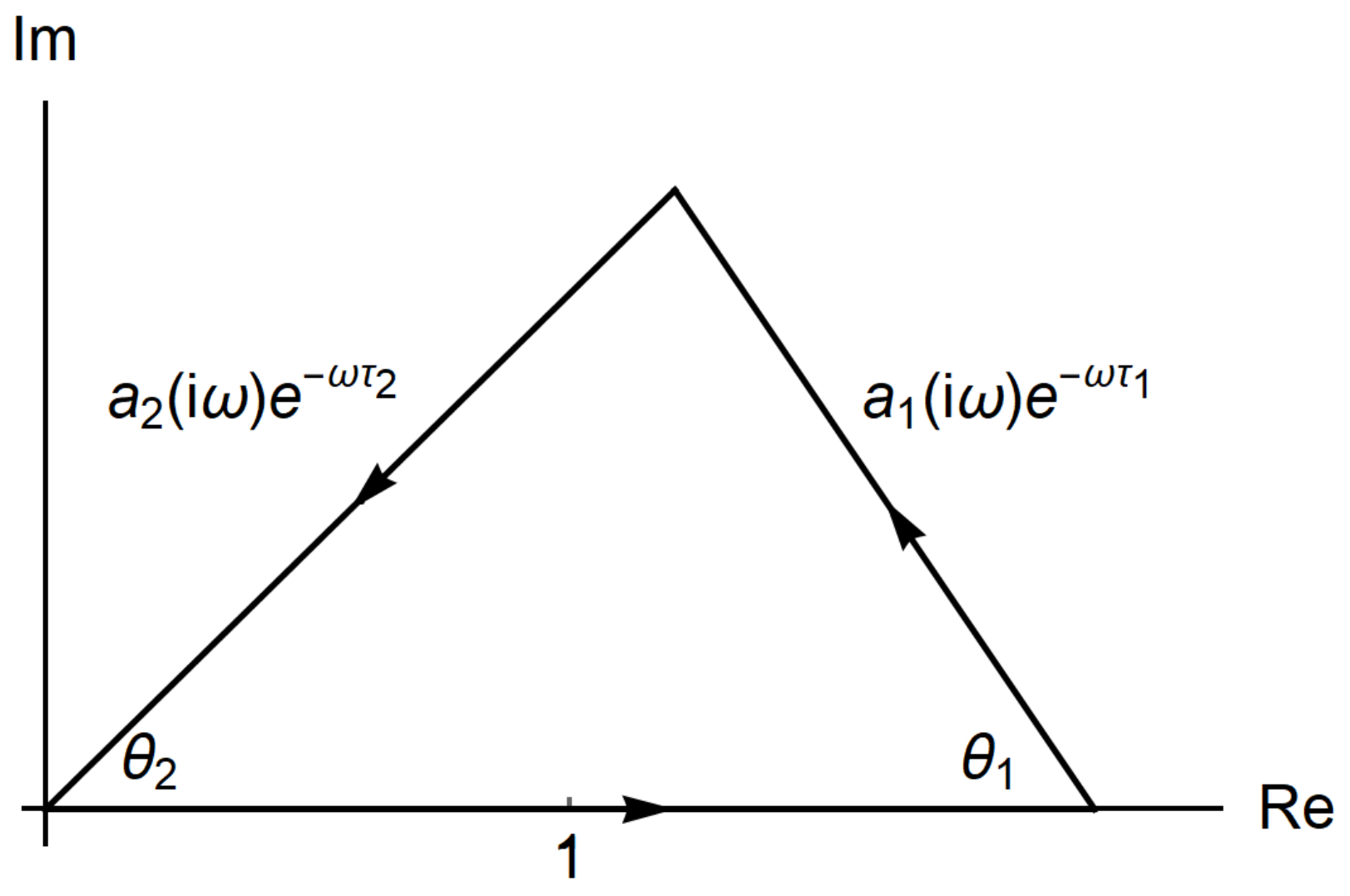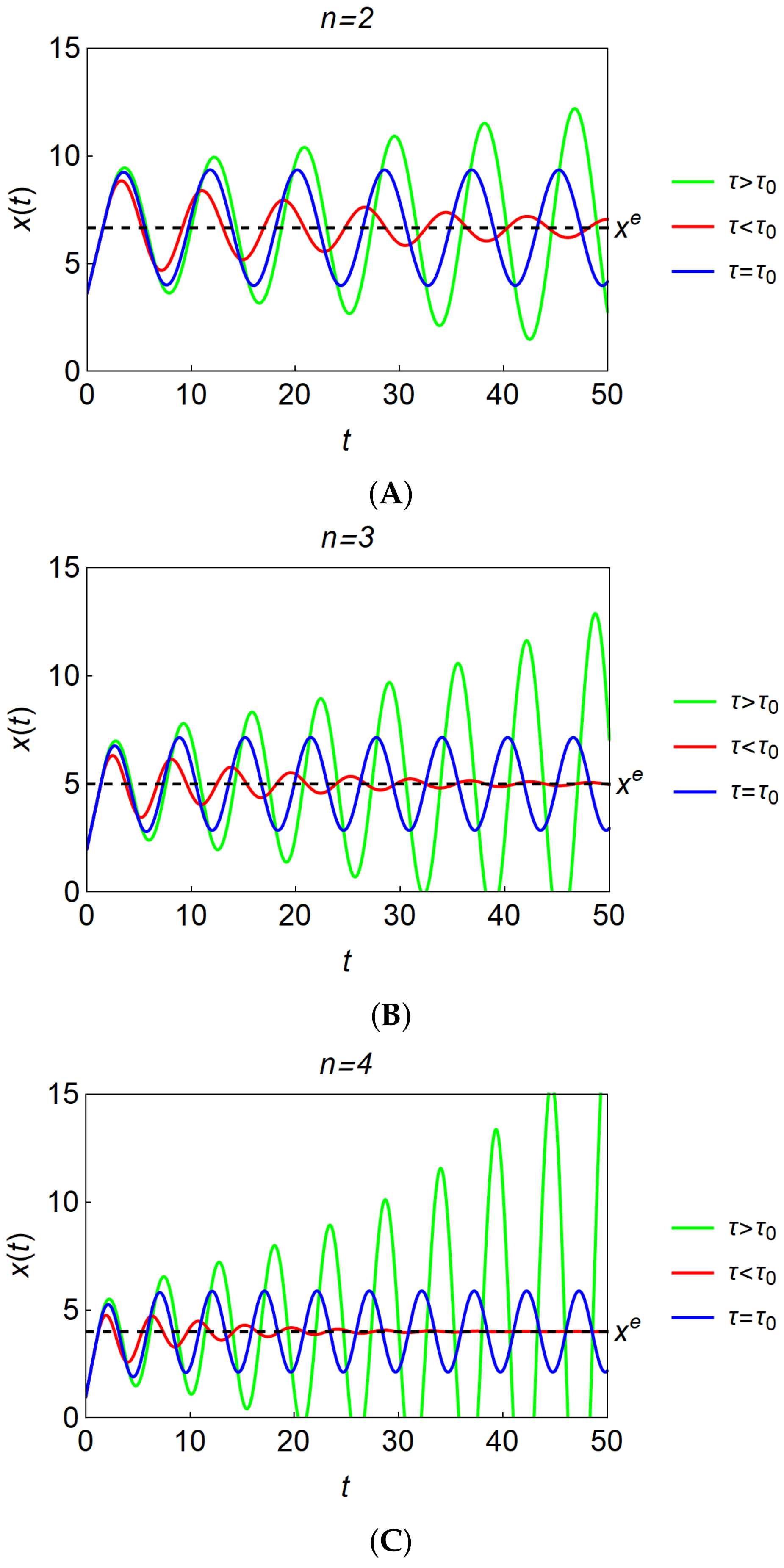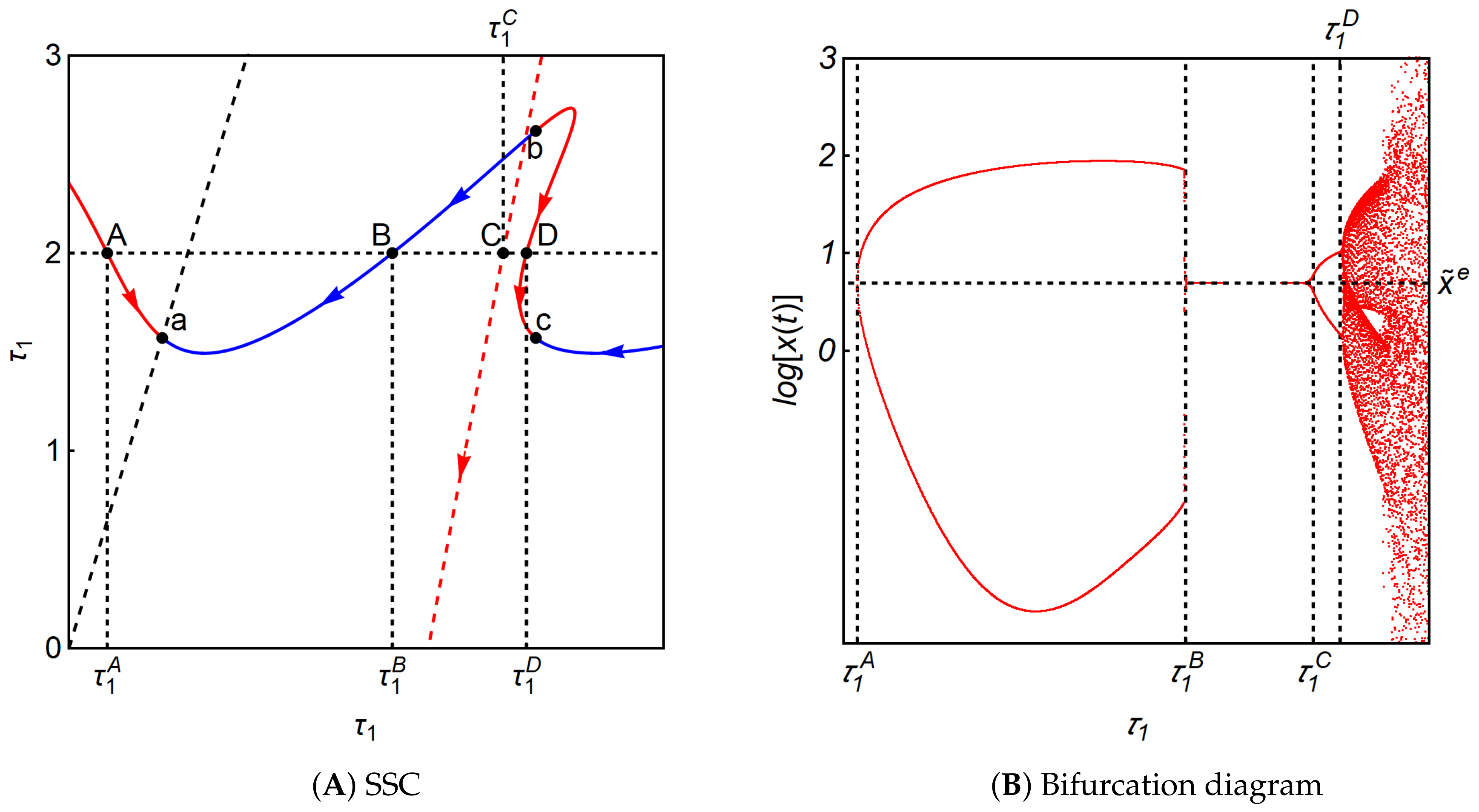In this section, we make one modification to the delay best reply dynamical system, (
1), and pursue the possibility of bounded dynamics when the system includes some nonlinearities. In particular, the growth rate adjustment is assumed in which the growth rate of output is controlled by the difference between the optimal output and the actual output,
System (
11) has the same stationary point as system (
1). The homogeneous part of its linearized version is
where
The remaining part of this section is divided into two. The stability switching curves under the growth rate dynamics are constructed and numerical simulations are performed in the first subsection. The stability index is examined to provide theoretical backgrounds with the directions of stability switches for the numerical results in the second part.
4.1. Stability Switching Curves
It is assumed henceforth that
K replaces
k. Then the pairs of (
) and (
) in (
4) and (
5) satisfy the following characteristic equation,
where the definitions of
and
should be changed to
and the interval
is redefined by
We then have two sets of line segments in the first quadrant of the (
) plane,
and
similar to the case of best reply dynamics. Lemma 1 characterizes the relations of the segments
and
for the extreme values of
in interval
I.
Lemma 1. holds for the initial point of I, and holds for the terminal point of I, .
Proof. Substituting
into (
14) and (
15) gives
implying that
and
Hence
at the initial point of
I. In the same way, for
implying that
and
Hence at the terminal point of I. This completes the proof. □
Pairs of (
) and (
) from (
7) and (
8) satisfy the characteristic equation,
where the definitions of
and
should be changed to
and
and the interval for
is defined, respectively, by
and
We also have two line segments of (
),
and
similarly to the case of best reply dynamics. Similarly to Lemma 1, we have the followings:
Lemma 2. In the case of holds for the initial point of , and holds for the terminal point of , .
The equality of the segments does not hold at the initial point of but only at the terminal point which can be proved similarly to Lemma 1.
Lemma 3. In the case of holds for the terminal point of ,
If , then the following result holds.
Lemma 4. In the case of holds for the initial point of , and holds for the terminal point .
In the following, we will construct stability switching curves. To this end, we specify the parameters’ values as
and
In
Figure 3, the dotted red loci are described by
with
and
and the dotted blue locus by
. The black point
is the initial point of
and
and its coordinates are
at which
holds by Lemma 1. The black point
is the terminal point of
and
and its coordinates are
at which
holds by Lemma 1. The blue and red solid curves are described by
and
They are connected at point
a,
at which
by Lemma 2.
The dotted and solid curves are smoothly connected as is seen in
Figure 3. As a result, the (
) region is divided into two subregions by the stability switching curve connecting the left-most parts among the segments of
, and
As the Cournot equilibrium is stable when there are no delays, it is stable in the region including the origin and left to the connecting curve.
We want to investigate the influence of
and
Two simulations in the case of
are performed with initial functions,
The first simulation result along the diagonal is presented in
Figure 4A. The delays increase from
to
with an increment of
along the diagonal. The Cournot equilibrium is asymptotically stable for smaller delays and becomes unstable through a Hopf bifurcation at
producing a limit cycle that further bifurcates to a multi-periodic cycle for larger delays. The second result with the different two delays is given in
Figure 4B. The value of
increases from
to
along the dotted horizontal line at
. More precisely, the bifurcation diagrams with two delays are constructed in the following procedure with
Mathematica, version 12.1. The value of
is fixed at
and the value of
is increased from
to
with an increment
. For each value of
dynamic system (11) runs for
and the data for
are discarded to get rid of the initial disturbance. The local maxima and minima out of the remaining data are plotted against this
value. Then the value of
is increased and then the same procedure is repeated until
arrives at
The following bifurcation diagrams are obtained in the same way. The resulting bifurcation diagram shows that the dynamic system experience similar dynamics. The stability of the equilibrium point is confirmed for the zero delay and holds for
and
In both diagrams (and the following diagrams), notation
is used.
We now increase the number of firms to
Figure 5A shows the stability switching curves. The line segments of
(i.e., the solid blue curve) and
(i.e., the solid red curve) take the
L-shaped profile and rotate counter-clockwise at point
a to the extent that the solid red curve is located furthermost to the left. By Lemma 4, both line segments head to point
the terminal point as
increases to
We simulate the model (
11) along the diagonal (i.e.,
) and the dotted horizontal line at
(i.e.,
) in
Figure 5A. As we find qualitatively no big differences between these simulation results as in
Figure 4A,B, we depict only the bifurcation diagram with different delays in
Figure 5B. It is seen that alá “period-doubling bifurcation” occurs in which the Cournot equilibrium is asymptotically stable for
(≃1.136), loses stability at
and bifurcates to a limit cycle from which new limit cycles emerge having a doubled period of the cycle as
increases from
We also see that further increasing
gives rise to complicated dynamics that suddenly shrinks to a limit cycle with multiple local maxima and minima at some critical point.
In the case of
, as is seen in
Figure 6A, the solid red and blue segments rotate counter-clockwise further at point
a, leading to that the red segment crosses the vertical axis. In
Figure 6B, we see that the bifurcation diagram gets more complicated and various dynamics can emerge.
Lastly, we simulate system (
11) with
The shape of the stability switching curve is different from those with smaller
n. In
Figure 7A, the positive-sloping dotted line is the diagonal, the dotted-red line is
as before and the black dots are the starting or ending points of the segments. A remarkable difference is that the solid red-blue segments consist of the wave-shaped curve. Accordingly, the bifurcation diagram is obtained along the horizontal dotted line at
and exhibits a different route to chaos. The stability of the Cournot equilibrium is lost at
(≃0.646), regained at
(≃5.441), and then lost again at
(≃7.306). Unstable oscillatory trajectories get complicated for
(≃7.697). It is known that time delays destabilize dynamic systems. This simulation, however, indicates that time delays can also stabilize the systems.
Dynamic system (
11) examines the birth of complicated dynamics through a period-doubling bifurcation and the occurrence of stability loss and gain. Needless to say, time delays play prominent roles. In addition, taking account of the fact that only the firm’s number is different in those numerical studies, the larger number could influence the system’s dynamics by increasing the degree of interactions among the firms.
4.2. Stability Index
We compute the stability index to provide a theoretical background for finding directions of stability switches. First, we denote the second and third vectors of (
3) by
and
and
Having
and
we further denote the real and imaginary parts by the followings:
and
Finally, the stability index is defined as follows:
hence
In the same way, we denote the second and third vectors of (
6) by
and
and
The real and imaginary parts are the followings:
and
moreover, the stability index is as follows:
We call the direction of the curve that corresponds to increasing the positive direction. We also call the region on the left-hand side the region on the left when we head in the positive direction of the curve. Region on the right is defined similarly. Concerning the stability changes, we have the following result from Matsumoto and Szidarovszky (2018) that is based on Gu et al. (2005):
Theorem 2. Let be a point on the stability switching curves, when is a simple pure complex eigenvalue. Assume we look toward increasing values of ω on the curve, and a point moves from the region on the right to the region on the left. A pair of eigenvalues crosses the imaginary axis to the right if or . If or , then crossing is in the opposite direction.
The condition of the theorem is satisfied if all egenvalues are single. It can be proved that the multiple eigenvalues, if any, are isolated from each other, so do the corresponding points on the stability switching curve. Hence at these points, the directions of stability switching are the same as those in the points of their neighborhoods.
We now compute the stability index on the solid red segment of the stability switching curve in
Figure 3. The red segment is a locus of the following points,
From (
7) and (
8), we have
implying
when
. If
then the triangle reduces to a line such that
That is, in Equation (
13),
showing that
being the left endpoint of interval
I, given for
, which gives the common starting point of two line segments. In the case of Equation (
18),
If
this equals
if
which is the initial point of
I. If
then this expression is always zero, so cannot be
or
. If
, then this expression can be only
, when
, which is the left endpoint of interval
which gives again the common starting point of two line segments. In these points, the direction of stability switching is the same as that in the two connecting segments. So in the rest of the discussion, we will assume that
. Hence the stability index
is positive on the solid red segments of the stability switching curve. In
Figure 3, the arrows on the solid red segment indicate the positive direction and the red
R and
L mean the right and left regions along the red segment. As (
) moves from the
R-region to the
L-region and
, Theorem 2 implies that a solution pair of (
18) crosses the imaginary axis to the right. That is, stability is lost. As seen in
Figure 4B, the stability is lost at point
A with
when
increases along the horizontal dotted line at
Similarly, we can compute the stability index on the solid blue segment,
The stability index
is negative,
The blue L and R denote the right-region and the left-region with respect to the solid blue segment. Hence the stability is lost when a pair of crosses the blue segment from the L-region to the R-region.
Consider the stability switching on the dotted red segment located in the upper-left corner of
Figure 3. The segment is described by
The stability index is positive
showing that crossing these segments from
R to
stability is lost.
In the lower part of
Figure 3, there is a small segment of
where
so
Then
meaning that crossing this segment from the stable region, at least one eigenvalue changes the sign of its real part from negative to positive, implying stability loss.










